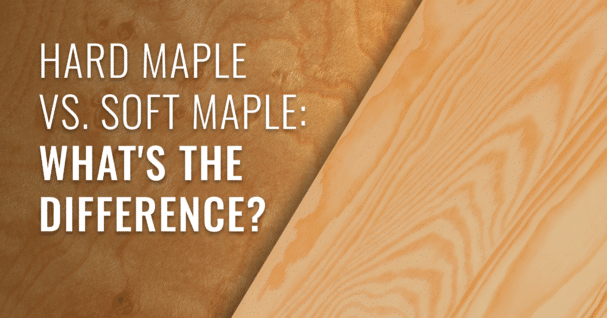
Maple trees are striking in any landscape with their vibrant display of fall colors in reds, golds, and yellows. But they’re also used for a vast variety of woodworking projects from furniture and cabinetry to flooring, even bowling pins and pool cues. Maple is one of the widest spread species of trees in North America and can be found in nearly every region of the continent. It’s a popular hardwood option among woodworkers for its affordability, yet durability. Let’s take a closer look at maple trees.
About Maple Wood
Maple wood is not only incredibly strong, it looks nice and stains beautifully. Woodworkers gravitate towards maple for its durability, smooth grain pattern, and light, creamy color. While most woodworkers tend to choose heartwood in other hardwoods, sapwood tends to be more popular for maples. Sapwood is found on the outer portion of the log and is lighter in color, lending itself to taking on many stain colors. It’s often used to mimic much more expensive hardwoods for the fact that it can take darker stains. You can learn more about wood stains in our post, What to Look For In Wood Stains.
While both hard maple and soft maple are commonly used to make furniture, cabinets, instruments, etc., hard maple is more commonly found in flooring as it’s denser and about 25% harder than soft maple. But, don’t let the word “soft” fool you. While maple can be described as both hard and soft, it’s not about the wood’s durability. Softwoods come from gymnosperm trees such as conifers — trees such as fir, pine, or cedar. Hardwoods include cherry, oak, and maple.
So, if it’s not about durability, what is the difference between hard maple and soft maple?
The Difference Between Hard Maple and Soft Maple
Hard maple is the common term for two species of maple trees — sugar maple (Acer saccharum) and black maple (Acer nigrum). As we mentioned, hard maple is commonly used for flooring, furniture, cabinets, pool cues, and many other finished wood products.
Soft maple is the common term for four species of maple trees — silver maple (Acer saccharinum), red maple (Acer rebrum), boxelder (Acer negundo), and bigleaf maple (Acer macrophyllum). Soft maple is commonly used for railroad crossties, boxes, pallets, crates, furniture, veneer, and woodenware. The flesh of soft maple trees resembles that of hard maple but is not quite as heavy, hard, or strong.
How to Tell Them Apart
Now that you know more about the differences between hard maple and soft maple, what’s the best way to tell the difference? Here are a few tips:
- Weigh the wood – If you are comparing two boards to establish if one is hard maple and the other soft maple, you can weigh an equal section of both and determine which is heavier. The heavier of the two is most likely to be hard maple, but this test isn’t always 100% accurate.
- Look at the end grains – Hard maple tends to have a lighter, more uniformed color while soft maple tends to be darker and includes red, brown, or gray streaks. Also, inspect the spacing between the growth rings. Hard maple tends to have growth rings more closely together due to its longer growing cycles.
- Look at the leaves – If the tree is un-harvested, you can check the leaves. Hard maple leaves will have U-shaped valleys, called sinuses, between the points of the lead, known as lobes. Soft maple leaves will have more V-shaped sinuses.
- Test with iron sulfate – Because of the different chemical compositions of the wood, you can apply a small amount of ferrous sulfate (also known as iron sulfate) to the wood. The iron sulfate will turn into a pale blue or green color on hard maple and dark blue or black on soft maple.
Is Maple Wood Eco-Friendly?
Being eco-friendly and earth-conscious is a big topic of concern more and more. We recently discussed how eco-friendly wood is in our post Why Wood Is One of the Most Eco-Friendly Materials. So let’s take a look at maple wood.
The good news is that not only is maple more affordable than many other hardwoods, it’s also a great option in terms of being eco-friendly. The trees grow in abundance and they are harvested in a sustainable manner, typically sourced locally. Plus, it can be stained to look like other types of wood, such as mahogany that may not be as sustainable or eco-friendly.
When you’re looking for hardwood that’s not only versatile and more affordable but also looks beautiful, hard or soft maple wood might be something to consider. And if you’re still not sure which hardwood is right for your project, take a look at our Hardwood lumber buying guide or contact us and one of our experienced team members will be happy to answer your questions.



